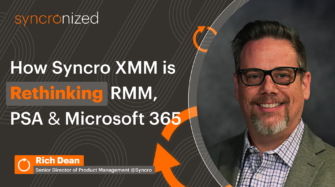Patch management — the process of planning and applying updates across systems — is one of the most important aspects of preventing a security breach. In fact, a Ponemon Institute report found that 60% of breaches occurred due to missing patches.
In this post, we’ll take a look at the what, why, and how of patch management from an MSP’s perspective, including what not to do and key MSP patch management best practices.
What is MSP patch management?
Fundamentally, patch management is everything involved with keeping your systems updated. That includes identifying what systems need updates, deciding what updates to apply, scheduling updates, running updates, and testing.
Patch management applies to all the assets in an environment — PCs, servers, IoT devices, smartphones, network gear, software applications, and even drivers. Common examples of patches include operating system (OS) updates, application upgrades, and firmware updates.
There are three main categories of “patches” you can apply to a system:
- Security patches: Address system or software security vulnerabilities.
- Bug fixes: Address bugs from a previous release.
- Feature updates: Add new features and functionality to a system or software.
Note that these categories aren’t necessarily mutually exclusive. Often a single update will cover all three categories at once. For example, a Windows service pack (SP) is an update that rolls up a variety of fixes in a single release.
Patch management vs. vulnerability management
Some managed service providers use the terms “patch management” and “vulnerability management” interchangeably. But here’s the difference: Patch management processes focus on updates; vulnerability management has a broader scope.
Vulnerability management is the continuous process of discovering, prioritizing, and addressing security vulnerabilities. In many cases, vulnerability management triggers patch management tasks. For example, as part of your vulnerability management processes, you may discover security risks that you can remediate with software patches.
Benefits of a patch management policy
It’s important to be purposeful about patch management. That starts with creating and documenting an MSP patch management policy.
The three main benefits of a robust patch management policy are:
- Security posture: Not having an effective patch management policy is the digital equivalent of leaving your client’s office doors unlocked overnight — anyone can wander in and steal company assets.
- Regulatory compliance: In some cases, you need a patch management process to ensure client systems are compliant with relevant standards and regulations. For example, PCI DSS and HIPAA require prompt application of patches that address critical vulnerabilities.
- Productivity: In addition to enhancing clients’ security posture, patches can add new features, resolve compatibility issues, and improve application performance. As a result, effective MSP patch management can boost productivity.
MSP patch management dos and don’ts
Sometimes the easiest way to get started with a plan is to identify what not to do. To that end, here’s an MSP patch management checklist of what you should and should not do:
- Don’t depend on manual patch processes. Manual processes take time, and time is money for an MSP. Make manual patching the exception, not the rule.
- DO use automated patch management tools. Deploying patches across multiple IT environments is a lot easier when you use patch management software to automate patch installations.
- Don’t forget about third-party software. Insecure third-party software can make an otherwise secure system vulnerable.
- DO monitor third-party software for patches. Client IT environments might include a lot of applications that release frequent updates.
- Don’t squash productivity. Patching is important, but context matters. Forcing a user to reboot during the workday to install a patch for a vulnerability with a low severity isn’t generally a good idea.
- DO minimize downtime. Ensure your patch management strategy accounts for client business hours.
- Don’t neglect testing. Not every update is a net positive. If you’ve been in IT long enough, you know updates come with some risk. If you’re new to IT, here’s some foreshadowing:
Testing helps you avoid falling victim to “bad updates”
- DO make time for testing patches. Testing should be part of your patch installation process.
- Don’t reinvent the wheel. You should have a patch management process that meets your customer’s business needs. However, you don’t have to start from scratch.
- DO look at examples and guidance. NIST 800-40 can get you started, but if you don’t have time to read 20+ pages, UC Berkeley’s Patching and Updates Guidelines might be more your speed.
MSP patch management best practices
There’s never a one-size-fits-all answer in IT, but these best practices can help you jumpstart and optimize your patch management workflows.
Establish and document a patch management policy
Use tools that automatically enforce your patch policies. For example, Syncro allows you to assign specific update policies for different IT assets. You can codify granular policies, manage patch dependencies, avoid documentation drift, and enforce policies automatically.
Think about patching during procurement
The software and hardware you buy today is what you’ll have to patch tomorrow. If you’re responsible for procuring IT assets for your clients, consider patch management during the buying process. Key questions to answer include:
- Does the vendor release patches for their products? How often?
- Is there an easy way to apply updates once they’re released?
- Do updates require the product to reboot or be taken offline?
- How does the vendor notify users about critical security patches?
- Does the vendor disclose vulnerabilities publicly?
- Has the vendor’s product been involved in a previous security breach?
Centralize asset management
Centralizing IT assets in a single system makes it easier to understand and report on upgrade status, enforce patch policies, and improve infrastructure visibility. For MSPs, RMM software is the right solution. In addition to centralizing assets from multiple clients and sites in a single system, an RMM can automate patch deployments and patch prioritization.
Track patch statuses
It’s one thing to schedule patches; it’s another to know if patch installation was successful. Monitoring software patches is important for catching patch failures, rejected patches, and missing patches.
Prioritize patches by severity
Usually, it makes sense to apply a critical security hotfix as soon as practical. But for minor issues, it doesn’t make sense to force a midday update that reboots your client’s PC to push a patch. Use CVSS scores and business context to decide when and how to apply patches.
Syncro can simplify your MSP patch management
Without the right patch management software, managing patches across different customers and sites can become time-consuming and inefficient. Syncro is all-in-one cloud-based MSP software that helps you scale and automate patch management
With Syncro’s RMM agents installed on customer PCs and Macs, you can:
- Run patch management reports to quantify which assets are missing patches
- Create patch management policies that automate how patches are installed based on patch type and severity
- Create policies for third-party app patches
- Schedule updates and required reboots around client business operations
- Maintain an audit-ready lot of all patch management activities
- Minimize human error in your patch management processes
- Deploy patches across an entire network
With Syncro, you have the control and visibility needed to patch the systems you’re responsible for, and the flexibility to choose the right balance of security and usability.
For example, you can customize Windows patch management rules based on KB Number, define patch exclusions for specific apps, and set reboot parameters.
The best patch management software for MSPs
Syncro is an all-in-one solution with a powerful scripting engine for endless customization. With centralized patch management capabilities, a wide range of integrations, and AI-powered ticketing workflows, Syncro helps IT teams and MSPs do more, with less effort.
Take Syncro for a test drive in your environment. Sign up for a free trial today.
Share














